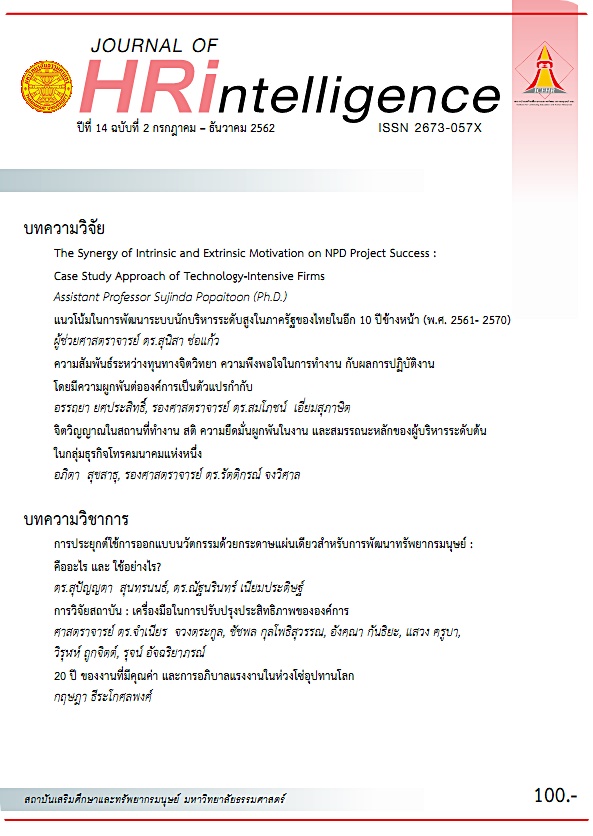The Synergy of Intrinsic and Extrinsic Motivation on NPD Project Success : Case Study Approach of Technology-Intensive Firms
Main Article Content
Abstract
The object of this research is to explore how motivation (intrinsic and extrinsic) works synergistically in the new product development (NPD) project team proceeding through three project stages (i.e., beginning, ongoing and finishing). Recently, scholars have found the synergistic roles of intrinsic and extrinsic motivation that work on new product development (NPD) projects particularly in the context of technology-intensive firms (TIFs). However, both types of motivation can appear in a temporary state that needs to motivate a project team continuously over long periods of project time. Based on Amabile (1993)’s motivation synergy theory, three illustrative case studies in TIFs provide the roles of motivation synergy (i.e., intrinsic and extrinsic) of a project team for each project stage. This research contributes to the literature of technology management, particularly in human resource management practices to enhance a project team’s synergistic motivation through a three-stage project to ensure the desired NPD project performance. Finally, this research proposes a set of propositions. Implications are discussed.
Article Details
ขอมอบลิขสิทธิ์บทความที่ได้รับการตีพิมพ์ให้แก่สถาบันเสริมศึกษาและทรัพยากรมนุษย์ กรณีมีการฟ้องร้องเรื่องการละเมิดลิขสิทธิ์เกี่ยวกับภาพ กราฟ ข้อความส่วนใดส่วนหนึ่ง และ/หรือข้อคิดเห็นที่ปรากฎในบทความ ให้เป็นความรับผิดชอบของข้าพเจ้าและผู้เขียนร่วมแต่เพียงผู้เดียว
References
Amabile, T. M., & Pratt, M. G. (2016). The dynamic componential model of creativity and innovation in organizations : Making progress, making meaning. Research in Organizational Behavior, 36, 157-183.
Bakker, R. M., Boro , S., Kenis, P., & Oerlemans, L. A. (2013). It's only temporary : time frame and the dynamics of creative project teams. British Journal of Management, 24 (3), 383-397.
Cerasoli, C. P., Nicklin, J. M., & Ford, M. T. (2014). Intrinsic motivation and extrinsic incentives jointly predict performance: A 40-year meta-analysis. Psychological Bulletin, 140 (4), 980.
Collins, C. J., & Smith, K. G. (2006). Knowledge exchange and combination : The role of human resource practices in the performance of high-technology firms. Academy of management journal, 49 (3), 544-560.
Deci, E. L. (1975). Intrinsic motivation. New York, US : Plenum Press.
Deci, E. L., & Ryan, R. M. (1985). The general causality orientations scale : Self-determination in personality. Journal of research in personality, 19 (2), 109-134.
Deci, E. L., & Ryan, R. M. (1985). The general causality orientations scale : Self-determination in personality. Journal of research in personality, 19 (2), 109-134.
Frey, B. S. (1997). On the relationship between intrinsic and extrinsic work motivation. International journal of industrial organization, 15 (4), 427-439.
Ghoshal, S., & Nohria, N., (1989). Internal differentiation within multinational corporations. Strategic Management Journal, 10 (4), 323-337.
Gupta, A. K., & Govindarajan, V. (2000). Knowledge flows within multinational corporations. Strategic Management Journal, 21, 473-496.
Kalling, T. (2003). Organization-internal transfer of knowledge and the role of motivation: a qualitative case study. Knowledge and Process Management, 10 (2), 115-126.
Keegan, A., Ringhofer, C., & Huemann, M. (2018). Human resource management and project based organizing : Fertile ground, missed opportunities and prospects for closer connections. International Journal of Project Management.
Kessler, E. H., & Chakrabarti, A. K. (1996). Innovation speed : A conceptual model of context, antecedents, and outcomes. Academy of Management Review, 21(4), 1143-1191.
Locke, E. A., & Latham, G. P. (1990). A theory of goal setting & task performance : Prentice-Hall, Inc.
Lin, H.-F. (2007). Effects of extrinsic and intrinsic motivation on employee knowledge sharing intentions. Journal of information science, 33(2), 135-149.
Makri, M., Lane, P. J., & Gomez-Mejia, L. R. (2006). CEO incentives, innovation, and performance in technology- intensive firms : a reconciliation of outcome and behavior-based incentive schemes. Strategic Management Journal, 27 (11), 1057-1080.
Osterloh, M., & Frey, B. S. (2000). Motivation, knowledge transfer, and organizational forms. Organization Science, 11 (5), 538-550.
Petison, P., & Johri, L. (2006). Driving harmony : philosophy of Toyota Motor Thailand. Strategic Direction, 22 (11), 3-5.
Petison, P., & Johri, L. M. (2008). Localization drivers in an emerging market : case studies from Thailand. Management Decision, 46 (9), 1399-1412.
Potter J. & Wetherell, M. (1987). Discourse and Social Psychology : Beyond Attitudes and Behaviour. London : Sage Publications.
Popaitoon, S., & Popaitoon, P. (2016). Motivation synergy, knowledge absorptive capacity and NPD project performance in multinational automobiles in Thailand. The Journal of High Technology Management Research, 27 (2), 129-139.
Popaitoon, P., & Rayton, B. A. (2012). Employment relationship in context : Commitment-based HR practices in the UK and Thailand. Journal of General Management, 37 (3), 21-37.
Popaitoon, S., & Siengthai, S. (2014). The moderating effect of human resource management practices on the relationship between knowledge absorptive capacity and project performance in project-oriented
companies. International Journal of Project Management, 32 (6), 908-920.
Porter, M. E. (Ed.). (1986). Competition in global industries. Harvard Business Press.
Project Management Institute (PMI). (2008). A guide to the project management body of knowledge (PMBOK® Guide-Fourth edition. Newtown Square, PA : Author.
Schmid, B., & Adams, J. (2008). Motivation in project management : The project manager's perspective. Project Management Journal, 39 (2), 60-71.
Shaw, J. D., & Gupta, N. (2015). Let the evidence speak again! Financial incentives are more effective than we thought. Human Resource Management Journal, 25 (3), 281-293.
Smith, J.A., (1995). Semi-Structured Interviewing and Qualitative Analysis. In : Smith, J.A., Harre, R. & Langenhove, L. V., Rethinking Methods in Psychology. London : Sage Publications.
Szulanski, G. (1996). Exploring internal stickiness : impediments to the transfer of best practices within the firm. Strategic Management Journal, 17, 27-43.
Thailand Board of Investment. (2016). Opportunities in Thailand’s automotive industry. Retrieved from http://www.boi.go.th
Thai Autoparts Manufacturers Association (TAMA, 2018). Retrieved from http://www.thaiautoparts.or.th
Wheelwright, S. C., & Clark, K. B. (1992). Creating project plans to focus product development. Harvard Business Review, 70, 70-82.
Yin, R. K. (2013). Case study research: Design and methods : Sage publications.
Zander, U., & Kogut, B. (1995). Knowledge and the speed of the transfer and imitation of organizational capabilities : an empirical test. Organization Science, 6, 76-92.
Zhao, Z. J., & Chadwick, C. (2014). What we will do versus what we can do : The relative effects of unit-level NPD motivation and capability. Strategic Management Journal, 35 (12), 1867-1880.

